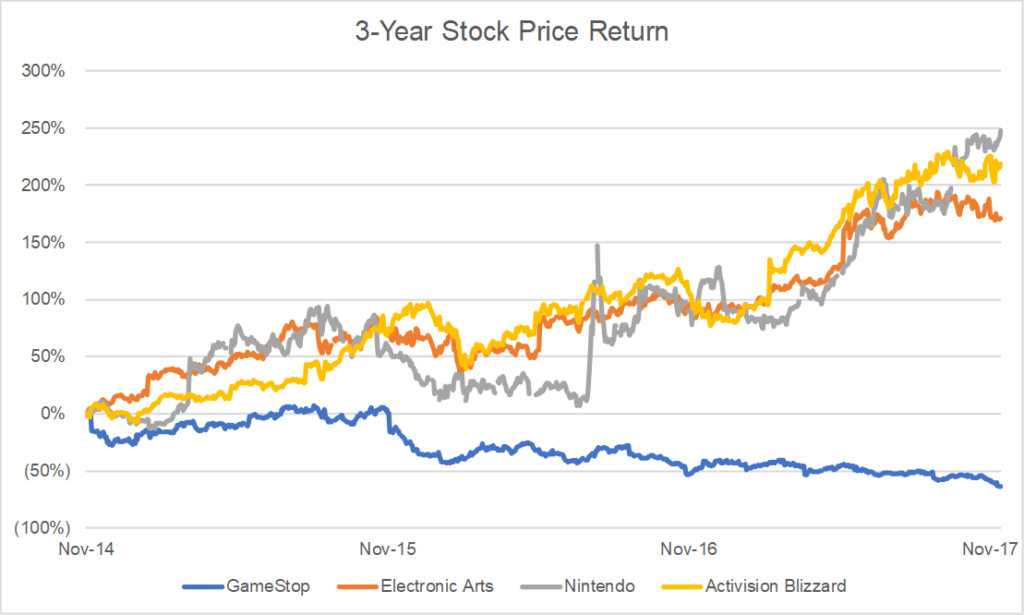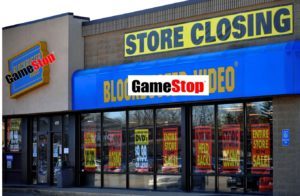GameOver for GameStop?

Suppliers and customers agree that digital distribution is the way of the future for videogames. So what should GameStop, the industry's leading physical retailer, do?
Digitalization Eating Traditional Retail Alive
What do you do if you’re a specialty retailer in the early 2000’s as you watch purchasing shift online? Build an e-commerce website and try to create an omni-channel offering. Now, what happens if your suppliers and customers create a distribution method that disrupts your supply chain and cuts you out completely?
This is the challenge that GameStop, a videogame retailer, faces as consumers have increasingly purchased “digital downloads” directly through their consoles, eschewing traditional retailers completely. Console manufacturers such as Microsoft and Sony, and game developers such as Valve and EA, have created new distribution channels that offer consumers instant downloads, and allow themselves to capture a larger portion of the profits.
The industry is approaching a tipping point, videogame publishers are generating 30% of revenues from digital downloads, compared to 10% in 2013 [1]. And for blockbuster games, that percentage can approach 50% [2]. This means that GameStop needs to prepare for a future where it generates profits from new offerings in order to support the massive fixed costs it has from its large retail footprint.
Adapting In Order to Survive?

Investors and GameStop’s management are clearly concerned with the company’s prospects; its stock price has fallen 70% since its 2013 highs, while game publisher and console manufacturers’ stocks are all reaching all-time highs as industry-level sales balloon to over $100 billion [3].
A few weeks ago, the company announced a new game rental subscription called PowerPass: for $10/month users can rent as many pre-owned games as they’d like by going into a physical GameStop location (and then get to keep one game at the end of 6 months) [4]. The company then promptly announced that it was abandoning the program before it even had a chance to formally launch [5]. On the company’s last earnings call, the CEO declared, “we continue to face pressure in pre-owned. Our results were within our forecast at a minus 7.5% decline. Inventory levels, a key driver of performance in this category, are stronger at plus 8% per year — or year-over-year” [6]. GameStop’s pre-owned inventory levels continue to increase while they face difficulty in actually selling these games.
PowerPass does not seem like a new long-term vision for GameStop, it seems like a way for it maximize cashflow as it slowly goes out of business. GameStop has built up a large inventory of pre-owned games, and it seems questionable that it would be able to fully monetize this stash, or even maintain current pre-owned sales or inventory levels. As more and more customers purchase digitally, customers have fewer physical games to sell back to GameStop, so GameStop’s funnel to purchase pre-owned games will continue to shrink.
What Can GameStop Do?

Digital Transition: It seems likely that GameStop will end up somewhere in-between Blockbuster and Netflix, which shouldn’t provide much comfort to investors or management. Netflix was able to transition from a physical-inventory-focused company to a leading player in the digital arena by partnering with content producers and purchasing the digital rights to underlying content. While there are digital distribution networks for games, none provide content producers with large guaranteed sums in exchange for the unrestricted right to distribute and market the content. The problem that Gamestop would face is that while they could potentially execute this strategy for PC, consoles are closed systems that prevent Gamestop from being anything more than a retailer for physical games.
Monetize Physical Footprint: Gamestop still has a dedicated customer base that continues to shop at its stores because of the breadth of product offerings, helpful staff, and store ambiance. Gamestop should evaluate if there are alternate uses for its store footprint that would cater to its customer base. One potential use would be converting some stores into arcades that attract (i) gamers that may not own the consoles / games and (ii) eSports teams and fans. eSports, or competitive videogaming, is a growing industry with hundreds of millions of fans and >$700mm of industry-wide revenue (forecast to approach $2bn by 2020) [7]. Professional sports teams, universities, and venture capitalists have flocked to eSports to try and build adequate infrastructure that will allow them to monetize the large fanbase. Gamestop could convert some of its space into arcades that allow (i) teams to train / compete and (ii) fans to gather and watch their favorite teams. This would also be a logical place to sell games, merchandise, and even pre-paid cards which allow for digital downloads once the game returns home.
Outstanding Questions
Are there examples of distributors that, like GameStop, have been disintermediated by their suppliers + customers?
Are there examples of retailers that have successfully found alternative uses for their retail footprints?
What other ways can GameStop pivot to remain relevant with its customer base?
(796)
[1] Dan Gallagher, “Downloads Add Upside for Videogame Publishers”, The Wall Street Journal, November 4, 2017, https://www.wsj.com/articles/downloads-add-upside-for-videogame-publishers-1509804001, accessed November 2017.
[2] Activision Blizzard Inc., November 2, 2017 Form 8-K, https://www.sec.gov/Archives/edgar/data/718877/000110465917065640/a17-24904_1ex99d1.htm, accessed November 2017.
[3] “The Global Games Market Will Reach $108.9 Billion in 2017”, Newzoo, https://newzoo.com/insights/articles/the-global-games-market-will-reach-108-9-billion-in-2017-with-mobile-taking-42/, accessed November 2017
[4] Jordan Crook, “GameStop is launching a game rental subscription called PowerPass”, TechCrunch, October 30, 2017, https://techcrunch.com/2017/10/30/gamestop-is-launching-a-game-rental-subscription-called-powerpass/, accessed November 2017.
[5] Chaim Gartenberg, “GameStop’s unlimited used game rental subscription gets shelved before it even started”, The Verge, November 14, 2017, https://www.theverge.com/2017/11/14/16650150/gamestop-unlimited-game-rental-subscription-powerpass-used-cancelled, accessed November 2017.
[6] Paul Raines, CEO, remarks made at GameStop’s Q2 2017 earnings call, August 24, 2017. From transcript provided by SeekingAlpha, https://seekingalpha.com/article/4101789-gamestop-corps-gme-ceo-paul-raines-q2-2017-results-earnings-call-transcript, accessed November 2017.
[7] “Esports revenues will reach $696M in 2017 and $1.5Bn by 2020”, Newzoo, https://newzoo.com/insights/articles/esports-revenues-will-reach-696-million-in-2017/, accessed November 2017



This is a fantastic article that poses a serious question about how retailers can continue to provide value in an era of increasing digitization. I completely agree with your assertion that GameStop’s value proposition has drastically diminished, and that they are struggling to retain relevance. Since I don’t believe that GameStop can beat publishers directly by providing games digitally, I think that they should double down on providing memorable experiences in the store that could only happen with physical copies of the games. For hardcore gaming enthusiasts, collectors editions of games are highly coveted. From their beautiful packaging to the colorful artwork and memorabilia inside, these products provide an element of artistic enjoyment beyond just the gigabyte storage required for the game to be played. GameStop should collaborate with video game publishers to provide these types of products to customers, and to help build events that would create an enormous amount of hype around certain video game release dates. While this offering may only peak the interest of hardcore gaming enthusiasts, it begs the question as to whether GameStop should make an effort to scale down and focus on a more niche market of hardcore gaming aficionados.
One, this is a fascinating approach for a nerdy topic. I think GS could use someone like you heading up Corporate Strategy.
Are there examples of distributors that, like GameStop, have been disintermediated by their suppliers + customers?
I think every retailer that has been impacted by Amazon would fall under this, but Blockbuster would be the most obvious example.
Are there examples of retailers that have successfully found alternative uses for their retail footprints?
The fact that they do not own their retail footprint and that is is located in mall/strip mall environments, which are experiencing gradual reduction in headcounts makes this a tough trend to reverse. I’m grasping at straws here, but how about movie theaters changing their revenue mix from being based upon ticket revenue to being concessions and advert focused?
What other ways can GameStop pivot to remain relevant with its customer base?
How about becoming the training academy for eSports teams? It could organize local leagues, akin to Little League, and hone the talent in a European soccer or LatAm baseball “academy” style.
At the risk of outing the true identity of Oswald Cobblepot, I am a lifelong video game enthusiast, and this topic has been bandied around the gaming community quite a bit. This piece does a great job of articulating the major issues; however, I would argue that Gamestop (in its current form) is not just a declining business, its a fish with its head cut off that is still flopping around on the deck. Digitally distributed games will continue to increase as both a percentage of revenue and of volume overall, particularly as mobile is by far the fastest growing segment in the market, and I do not see much of a future for hardcopy games outside of the inordinately and bizarrely popular and ludicrously expensive collectors editions mentioned in the article.
I completely side with the author that Gamestop needs to move to an experiential model that focuses on eSports coverage, gaming trials, and limited “in-person” experiences. Beyond the arcade concept, I think there is an opportunity to partner with the many hardware providers (e.g., Alienware, NVIDIA, Steam, etc.) to provide trial access to upscale gaming rigs and new platforms, which generally require a large amount of time and money to fully experience. As gaming becomes more of a mainstream activity (finally!! so I can talk about it in public more), there is a significant opportunity for GameStop to monetize community experiences and survive the impact of digital distribution.
Interesting piece! Very thoughtful analysis of the problems facing Gamestop and smart suggestions for how it can try to survive (surely a challenge, as you acknowledge). Even before Blockbuster’s collapse, large music retailing chains like HMV and Virgin Records also disappeared. In a world where it no longer made sense to distribute content in a physical medium, they could not find a new compelling existence. The record stores and video stores that still exist are local, independent ones with a strong community following for true classic fans, and those too are struggling. Movie theaters, however, have remained a decent business, and concerts are as popular as ever. That is because going to a movie theater is still a communal experience and concerts offer both a communal experience and an ability to see something live in its best format, like eSports could be (concerts also make money on selling associated merchandise). I agree with you and Oswald that experiential is the way to go. Movie theaters and concerts, I believe, provide two additional supporting pieces of evidence for this hypothesis.
Thanks for the reflection – I think that you did a nice job highlighting a number of interesting issues currently facing Gamestop. In reflecting on the issues confronted by Gamestop, I wonder if there is an opportunity to launch a PowerPass-like digital platform, thereby enabling gamers to access a wide library of games (likely not new releases) – somewhat similar to the Netflix model (potentially with purchasable content as well). Additionally, along the lines of what you had proposed with converting retail locations to arcades, I think Gamestop could potentially benefit from placing stores in high foot traffic areas and incorporating experiential elements such as the ability to compete in tournaments or try out games before playing. Finally, it seems like Gamestop has made only a half-hearted attempt to be the go-to location for purchasing consoles due to limited price competition, which may be giving up the option to be the retailer of choice thereafter when considering additional game purchases.